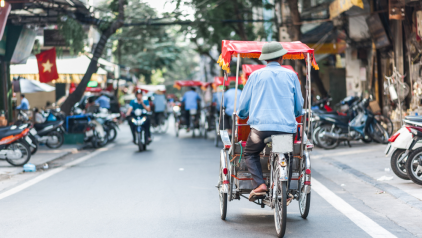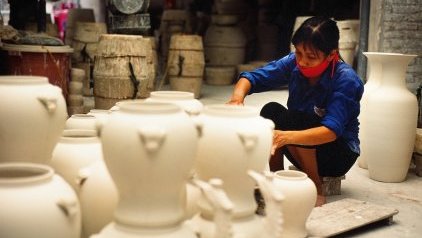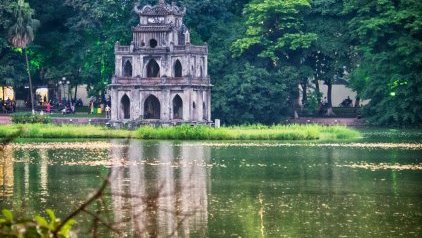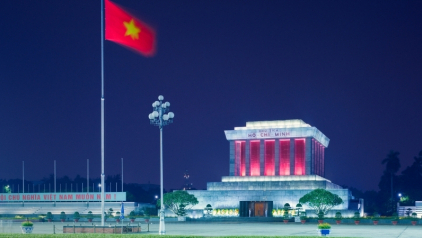Hanoi Travel Guide - All you need to know about Vietnam Capital
Being one of the most ancient capitals in the world, Hanoi is the right place for travelers who are looking for well-preserved colonial buildings, historical attractions, or just a glimpse of the traditional local lifestyle.
There are numerous war memorials, historical museums, prisons, mausoleums locating right in the heart of the city, especially Ho Chi Minh Mausoleum – the greatest leader in Vietnam history. As a multi-cultural community affected by Chinese, French and Russian, Hanoi is not only an old developing city but also offers vibrant nightlife, amazing local food, and many magnificent tourist attractions nearby, Ha Long Bay for example.
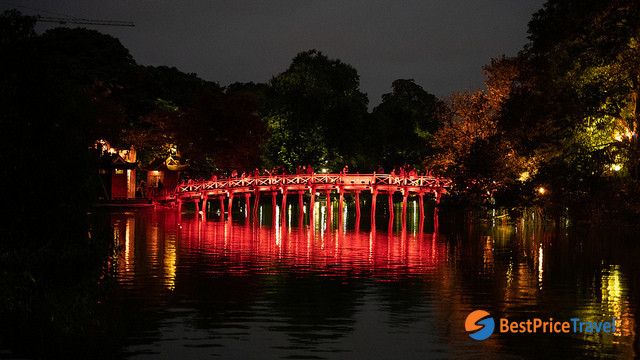
The Huc Bridge
Hanoi has been inhabited since at least 3,000 B.C., from the period of Co Loa Citadel (belonging to Dong Anh district) serving as the capital of Au Lac kingdom (Pre Thang Long-period), through many dynasties and wars (named Thang Long – Dong Do – Dong Quan – Dong Kinh), to being Vietnam’s capital in the present day.
1. Hanoi History
Hanoi was eclipsed by Hue – the imperial capital of Vietnam during the Nguyen Dynasty (from 1802 to 1945). From 1010 to 1802, Hanoi was considered to be the most important political center of Vietnam.
In 1873, the French conquered Hanoi, which made Hanoi into the French colonial administrative center from 1883 to 1945. During the period, the French built a modern administrative city, many churches, public buildings, luxury villas but also destroyed various imperial palaces and citadels, reduced lakes’ and canals’ sizes, which results in Hanoi as it is today.
Similar to most of the French colonized land in Indochina and Southeast Asia, the Japanese Empire took control over Hanoi. On September 2nd, 1945, President Ho Chi Minh proclaimed the Democratic Republic of Vietnam at Ba Dinh Square, which involved Hanoi in the most important milestone in Vietnam’s history. Afterward, Hanoi has become Vietnam’s capital on January 6th, 1946.
Top attractions in Hanoi
- Hanoi Old Quarter: For those who visit Hanoi with a genuine desire to have a grasp of the city’s culture, Ha Noi Old Quarter is a must-visit spot that you definitely should not miss. Despite the rapid development of a developing country’s capital, which results in constant changes every day, Ha Noi Old Quarter remains its ancient beauty but with a dynamic lifestyle. Most streets in the Old Quarter were named after each street’s original businesses dating back about 1,000 years ago. Isn’t it sound like a dream of traditional lovers?
- Duong Lam Ancient village: Different from Hoi An’s ancient town or Hanoi Old Quarter’s vibrant vibe of urban lifestyle in the earlier centuries, Duong Lam ancient village is more like a rural area, heavily affected by agricultural lifestyle. Retaining the basic characteristics of Vietnamese ancient villages, the village with its unique architecture has welcomed many tourists from all over the world. Covered with banyan trees’ generous shades, the village brings about a peaceful atmosphere at its best.
- Bat Trang Ceramics Village: If you are looking for an interesting activity that you can actually hand on, then Bat Trang Ceramics Village is the choice for yours. Located only 15km away from Hanoi center, Bat Trang village is a well-known attraction to tourists and locals who love traditional culture and new experiences at the same time. You can not only wander around the artists’ working place but also try hand-made pottery yourself with their help.
- Temple of Literature: Hanoi has numerous pagodas and temples, especially the Temple of Literature is one of a kind. Unlike other religious temples, the Temple of Literature is considered to be the first University of Vietnam. Nowadays, the temple is not only a historical attraction but also attracts many candidates, students coming to pray for their studying career.
You might interested: Top 10 authentic things to do in Hanoi – Discover the real Hanoi!
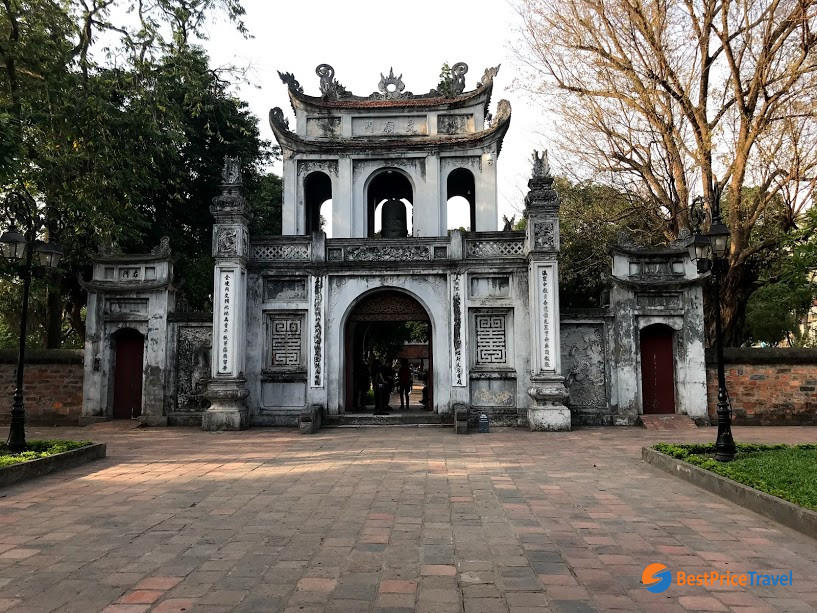
Temple of literature
3. Hanoi Culture
Generally, Hanoi people are often stereotyped to be more formal in the Southern or other area cities. Hanoi ethnic residents are often friendly and hospitable. However, Hanoi is a multi-cultural city with citizens coming from many other Nothern provinces looking for better opportunities, which results in some complex customs and people’s behaviors.
Hanoi, or other Northern parts of the country, pays more attention to religious and traditional festivals. If you love to experience the truest traditional festival culture, then you should join the Perfume Festival (hosted in Hanoi’s iconic Perfume Pagoda), Lim Festival (hosted in Bac Ninh province). The festivals do not just offer a true view of how locals celebrate such tradition, but also give travelers the chance to enjoy UNESCO-listed “Quan ho” folk singing, many folk games such as bamboo swings, cockfighting, tug-of-war, wrestling, blind man’s bluff, and human chess.
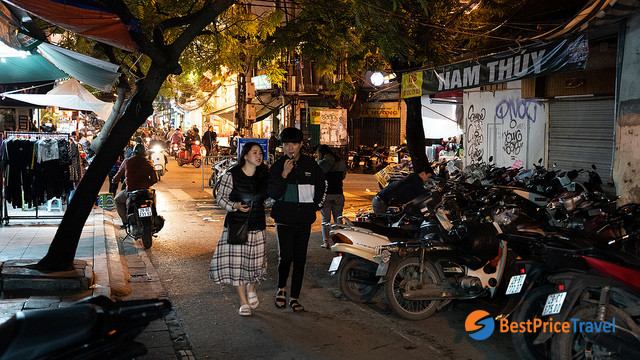
Hanoi local life
4. Weather in Hanoi
Featuring a warm humid subtropical climate, Hanoi has 4 different seasons. Summer is hot and humid with abundant rainfall from May to August. Decreasing temperature and precipitation, the Fall season is comprised of September and October. The city is usually cloudy and foggy but cool and dry during Winter (from November to next January).
Visitors often come to Hanoi from September to November or March to April, when the weather is mild, not too hot, or too wet. If you would prefer cold days for your stay, coming to Hanoi from November to March is suggested.
Do you want to discover the best time to visit Hanoi?
5. Hanoi Transportation
Hanoi is a compact city, in which travelers usually stay within center districts (Hoan Kiem, Ba Dinh, Tay Ho, or Hai Ba Trung). Getting around is quite convenient thanks to closely located attractions, restaurants, and hotels. You can either take a taxi or xe om (motorbike taxi), hire a private car, or travel around by bus. The prices are relatively cheaper in comparison with other cities in Vietnam.
6. Hanoi Travel tips
- Make sure you have enough cash: With many street vendors selling special local food to hand-made products, famous ancient attractions, you definitely need to bring more cash than usual since most of them don’t accept cards. Don’t waste your trip just to enjoy big chained restaurants and other modern activities when visiting a well-known-to-be-ancient city.
- Bargaining is needed: Hanoi treats foreigners as a different segment, hence, they charge foreigners (or Southern Vietnamese in some cases) higher than the locals. But they don’t mind bargaining and often accept fair trades.
- Don’t get into trouble: People are straightforward and easily get pissed through hard times. If you notice yourself getting into an unnecessary fight, just apologize and walk away for your most convenience.
- Money (Currency Exchange; where to change): Vietnamese official currency is Vietnam Dong. There are many Currency Exchange stations in tourist areas or city centers. You should exchange Vietnam Dong in Vietnam cities for better rates compared to exchanging abroad the country.
